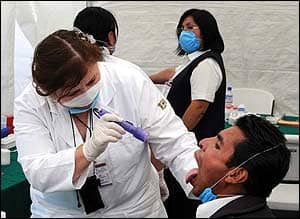While the initial panic caused by the sudden emergence and rapid spread of the infamous swine flu in April 2009 may have abated, federal officials are bracing for an expected onslaught this fall.
At the H1N1 “preparedness summit” at the National Institutes of Health, held in early July, federal officials forecast that the impact of the swine flu may worsen in October, when the regular flu season hits, or even earlier, when schools open. Indeed, the novel H1N1, a respiratory disease caused by the type A influenza virus, did not behave as a traditional seasonal flu and go underground in the summer months. According to Joe Quimby of the Centers for Disease Control (CDC), the H1N1 virus continued to infect people during the hot months in the United States and at least 100 other countries, particular in summer camps and military units. In addition, infections are becomingly increasingly widespread in the Southern Hemisphere, where flu season is under way.
 |
The H1N1 virus originally surfaced in the United States in mid-April and was declared a pandemic by the World Health Organization (WHO) in mid-June as it spread across North America, South America, Europe, and Australia to more than 120 countries.
“This is very real from a global perspective,” says Quimby, senior press officer for the CDC. “The numbers of reported cases in the US are unprecedented this summer.”
According to the US Centers for Disease Control and Prevention (CDC), the virus could affect as many as 40% of Americans, if you include workers who stay home to care for those with the illness. At the end of July, the CDC reported approximately 43,800 confirmed cases of H1N1 infection and 302 deaths in the United States.
While many of the estimated 1 million Americans infected with the virus experience mild symptoms and recover quickly, health officials are concerned that the virus could mutate and become more virulent. Of particular concern is that about half of the people killed worldwide were young and previously healthy. In contrast, regular forms of the seasonal flu typically prove most lethal to the very young and the elderly.
Preparing for a “Crafty Virus”
According to Quimby, the United States is better prepared today to combat this new influenza A virus because of the severe acute respiratory syndrome (SARS) outbreak in 2003.
“We have learned that influenza is a very crafty virus,” Quimby says. “It continues evolving, and there are many strains around the world.”
While the preparations to combat the flu with vaccine development and antiviral stockpiling are essential, rapid and accurate diagnostic testing is also an integral element to pandemic influenza preparedness. Diagnostics allow identification of H1N1 cases, help clinicians determine clinical treatment, and facilitate public health management.
The gold standard for diagnosis of influenza has been the traditional tissue culture, which isolates the virus. However, the turnaround time can be from 1 to 10 days compared to nucleic acid testing methods—the most common of which is reverse transcriptase polymerase chain reaction (RT-PCR)—which can detect influenza in 4 to 8 hours. Data has shown that the increased yield of viral identification by nucleic acid testing over culture ranges from 8% to 800%, increasing sensitivity (J Clinical Virol. 2008; 190-93). In addition, the majority of the reagents can be stored for years, and, while the initial financial outlay for equipment and training can be high, the platform can be used to test for numerous pathogens.
According to Andy Shrago, senior vice president of sales and chief marketing officer at Prodesse Inc, Waukesha, Wis, labs are moving from the point-of-care (POC) rapid antigen tests to molecular testing, recognizing that a quick turnaround time of 30 minutes does not necessarily translate into the most accurate diagnosis. Many negative samples from rapid tests have been confirmed by the CDC as swine flu.
Moving Toward Molecular Methods
“The move toward molecular testing is driven by the poor sensitivity of the rapid antigen tests, which the H1N1 outbreak has brought to light,” Shrago says. Neither the WHO nor the FDA recommend the use of rapid POC tests for the detection of the novel H1N1 virus because their performance has not been established for influenza A subtypes, and they cannot differentiate between a novel influenza virus or seasonal influenza.
Prodesse’s ProFlu+ Assay, which uses real-time PCR technology, is simple to use and easily integrates into existing lab workflow, Shrago says. In silico testing demonstrated that the assay would detect novel H1N1 and the ProFlu+ sequences are a nearly perfect match to every known swine flu sequence, meaning that there is a high probability that H1N1 will be detected by ProFlu+. In May, the company announced that several clinical labs using the product received CDC confirmation of positive swine flu from specimens initially identified as Influenza A by ProFlu+.
ProFlu+ has been optimized for the use of automated extraction technology so that minimal hands-on time is required. A result can be obtained in 3 hours. Assuming a run of 20 samples, this would indicate a turnaround time of a bit under 4 hours with hands-on time of about 45 minutes—or 2 minutes per sample. It can be used on multiple real-time PCR platforms.
According to Shrago, Prodesse had added a number of accounts in the past 2 to 3 months with many more in the works.
“They are telling us they are going to discontinue rapid antigen testing because their clinicians now recognize its severe limitations,” Shrago says.
The FDA and CDC are relying on real-time PCR detection of H1N1 for state public health labs, with the FDA issuing emergency use authorization for two such diagnostic tests. In late July, the FDA granted a third EUA to Focus Diagnostics, the infectious disease branch of Quest Diagnostics, Cypress, Calif, for its Influenza A H1N1 (2009) Real-Time RT-PCR—the first EUA granted to a commercial test for detection of the H1N1 virus. It is also the first to qualitatively detect RNA of the pandemic flu virus in a patient’s nasal or nasopharyngeal specimens.
The test targets two separate regions of the hemagglutinin gene of the 2009 H1N1 virus to differentiate the presence of the pandemic virus from seasonal influenza A virus. Turnaround time for reporting results is typically within 24 hours of receipt of the specimen. With the EUA, Focus can offer the test as a kit to other labs that are defined as Clinical Laboratory Improvement Amendments (CLIA) labs, provided they also run the necessary equipment. Quest Diagnostics, Madison, NJ, which operates labs in approximately 30 major metropolitan regions of the United States, is in the process of validating the test in approximately six labs in its network that may also perform the test in compliance with the EUA.
According to Focus Medical Director Jay Lieberman, MD, the assay detect three targets, one from influenza A in general, and two for novel H1N1 specifically. If the infection continues to spread, the greater testing capacity afforded through the availability of the Focus test will be critical to patient care, Lieberman says.
“The test is intended as an aid to clinicians to use in identifying patients infected with H1N1,” Lieberman says. “We do not know for sure if the test can identify all people who may get sick with the virus, so negative results do not preclude the virus infection and should not be used as the sole basis for diagnosis.”
Subtyping Tests Under Development
In development at Seegene, San Diego, is a multiplex PCR Flu A subtyping test, which builds on the Maryland company’s multiplex PCR technology platform. Plans are on track for release of the test, which is capable of simultaneously detecting the most common subtypes (H1, H3, and H5) of influenza in September, according to Hans Kim, director of global marketing at Seegene.
“We do not yet know what impact this pathogen and its variants will have as the regular flu season approaches,” Kim says. “So we are seeking reliable screening tools to rapidly expand testing capacity.”
Currently, the Seegene RV Detection assays provide a wide range of screening capabilities for influenza A, simultaneously testing for up to 18 other respiratory viruses in a single multiplex PCR test. During the H1N1 outbreak, the products can be used in conjunction with the company’s sequencing primer patch for final confirmation of novel H1N1. The product is used by approximately 200 hospitals worldwide, including in Mexico, Spain, and Korea.
According to Kim, Seegene’s multiplex PCR test returned the best results for screening for the novel H1N1 virus in a trial conducted by the Ontario Agency for Health Protection and Promotion. The Seeplex RV12 ACE Detection with the H1N1 primer patch showed 100% specificity and 95% sensitivity in testing in nasopharyngeal specimens.
By using the primer, any suspicious sample can be checked by a two-way detecting process. The first detection is by the influenza A conserved matrix gene primer, then subsequent or simultaneous detection is by the new H1N1 specific hemagglutinin gene primer.
One POC test that merits CDC attention is the POC influenza test by Meso Scale Diagnostics LLC, Gaithersburg, Md, which is currently undergoing evaluation in a multisite clinical trial. The test, which consists of a portable instrument and disposable test cartridges, reports results from a nasal swab sample within 15 minutes. In development since 2006 under a contract with the CDC, the test is designed to identify influenza A infection by subtype, differentiating between common human A (H1N1), common human A (H3N2), and the avian A (H5N1) influenza strains.
Currently available POC influenza tests detect influenza A and B without additionally detecting influenza A subtypes. Meso Scale’s investigational test was used in detecting the first identified case with infection with H1N1 flu.
Shannon Rose is a freelance health and medical writer based in Temecula, Calif.





